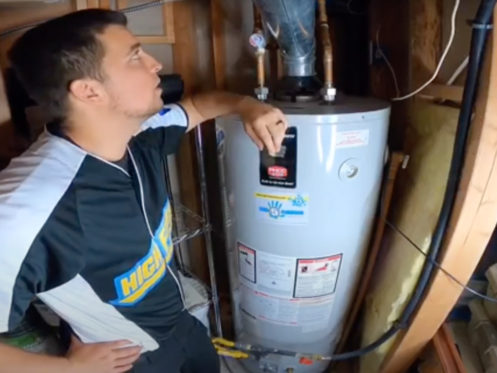Ensuring Longevity of Your Home's Hot Water System: Maintenance TipsEffective Techniques for Caring for Your Home's Hot Water System
Visit UrlWe've come across the article pertaining to Tips For Maintaining Your Hot Water Heater down the page on the internet and think it made good sense to relate it with you over here.

Warm water is important for day-to-day comfort, whether it's for a revitalizing shower or washing dishes. To guarantee your warm water system runs effectively and lasts much longer, regular upkeep is vital. This short article offers useful suggestions and understandings on exactly how to preserve your home's hot water system to prevent disturbances and pricey repair work.
Introduction
Maintaining your home's warm water system may seem challenging, yet with a couple of basic steps, you can guarantee it runs smoothly for years ahead. This guide covers everything from comprehending your hot water system to DIY upkeep ideas and knowing when to call expert aid.
Importance of Keeping Your Hot Water System
Regular maintenance not only prolongs the life expectancy of your warm water system yet additionally guarantees it operates efficiently. Ignoring upkeep can bring about decreased performance, greater power expenses, and even premature failure of the system.
Signs Your Warm Water System Demands Maintenance
Knowing when your warm water system requires focus can avoid major issues. Watch out for indicators such as irregular water temperature, strange sounds from the heater, or rustic water.
Recognizing Your Warm Water System
Before diving right into upkeep jobs, it's useful to understand the standard components of your warm water system. Commonly, this includes the hot water heater itself, pipes, anode poles, and temperature level controls.
Regular Monthly Maintenance Tasks
Normal regular monthly checks can assist capture small issues prior to they escalate.
Purging the Hot Water Heater
Flushing your hot water heater gets rid of debris buildup, boosting effectiveness and prolonging its life.
Checking and Replacing Anode Rods
Anode poles protect against rust inside the storage tank. Examining and changing them when worn is critical.
Checking and Readjusting Temperature Settings
Changing the temperature settings ensures optimal performance and safety.
DIY Tips for Maintenance
You can perform numerous upkeep jobs on your own to keep your warm water system in leading condition.
Checking for Leaks
Regularly inspect pipes and connections for leaks, as these can result in water damage and higher bills.
Testing Pressure Relief Valves
Testing the pressure relief valve ensures it operates appropriately and stops extreme stress build-up.
Insulating Pipelines
Insulating warm water pipes decreases warm loss and can conserve power.
When to Call a Specialist
While do it yourself upkeep is beneficial, some issues need expert knowledge.
Complicated Problems Calling For Specialist Aid
Instances consist of significant leakages, electric troubles, or if your hot water heater is constantly underperforming.
Regular Specialist Upkeep Conveniences
Professional maintenance can consist of detailed assessments, tune-ups, and making certain conformity with safety and security criteria.
Verdict
Normal upkeep of your home's warm water system is necessary for effectiveness, durability, and cost savings. By following these tips and knowing when to look for expert aid, you can make certain a trusted supply of warm water without unforeseen interruptions.
How to Maintain an Instant Hot Water Heater
Before tinkering with your hot water heater, make sure that it’s not powered on. You also have to turn off the main circuit breaker and shut off the main gas line to prevent accidents. Also turn off the water valves connected to your unit to prevent water from flowing into and out of the appliance. 2. When you’re done, you have to detach the purge valves’ caps. These look like the letter “T” and are situated on either side of the water valves. Doing so will release any pressure that has accumulated inside the valves while at the same time avoid hot water from shooting out and burning your skin. 3. When the purge valves’ caps are removed, you have to connect your hosing lines to the valves. Your unit should have come with three hoses but if it didn’t, you can purchase these things from any hardware or home repair shops. You can also get them from retail stores that sell water heating systems. Read the user’s manual and follow it to complete this task properly. When the hosing lines are connected, open the purge port’s valves. 4. You should never use harsh chemical cleaners or solutions when cleaning your unit. Make use of white vinegar instead. It should be undiluted and you’ll probably use about 2 gallons. 5. Now flush your water heater. This task should probably take about 40 minutes. We can’t give you specific directions for this because the procedure is carried out depending on the type, model and brand of your heater. With that being said, refer to the user’s manual. 6. When you’re done draining the unit, you have to turn off the purge port valves again. Remove the hosing lines that you earlier installed on each of the water valves. Put the valve caps (purge port) back in their respective places and be very careful so as not to damage the rubber discs that are found inside these caps. 7. Now that everything’s back in place, check your user’s manual again to find out how to reactivate your water heating system. 8. Once it is working, turn one of your hot water faucets on just to let air pass through the heater’s water supply pipes. Leave the tap on until water flows smoothly out of it. https://www.orrplumbing.com/blog/2014/september/how-to-maintain-an-instant-hot-water-heater/

As a fervent person who reads about How to Maintain a Hot Water Heater in a Few Simple Steps, I imagined sharing that piece of content was necessary. Are you aware of somebody who is interested by the topic? Please feel free to promote it. Thanks a lot for your time. Come back soon.
Call Today